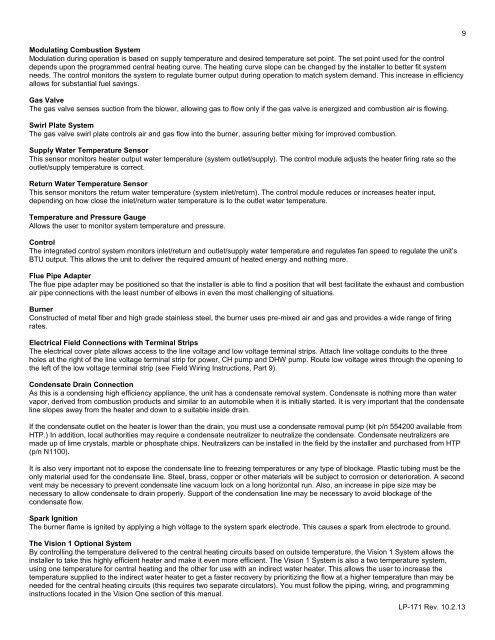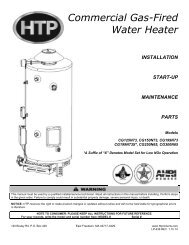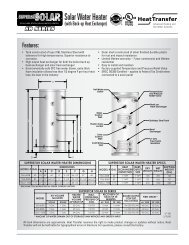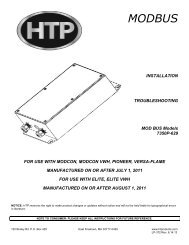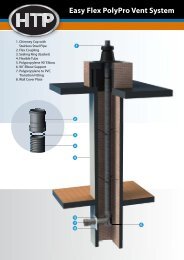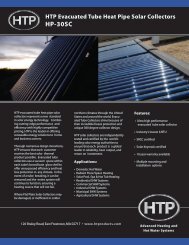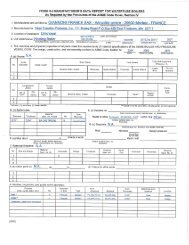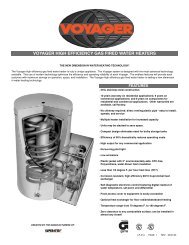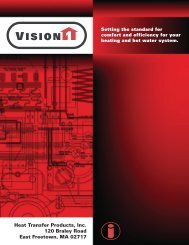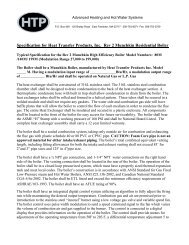MC Series Gas-Fired Circulating Heater - Heat Transfer Products, Inc
MC Series Gas-Fired Circulating Heater - Heat Transfer Products, Inc
MC Series Gas-Fired Circulating Heater - Heat Transfer Products, Inc
You also want an ePaper? Increase the reach of your titles
YUMPU automatically turns print PDFs into web optimized ePapers that Google loves.
Modulating Combustion System<br />
Modulation during operation is based on supply temperature and desired temperature set point. The set point used for the control<br />
depends upon the programmed central heating curve. The heating curve slope can be changed by the installer to better fit system<br />
needs. The control monitors the system to regulate burner output during operation to match system demand. This increase in efficiency<br />
allows for substantial fuel savings.<br />
<strong>Gas</strong> Valve<br />
The gas valve senses suction from the blower, allowing gas to flow only if the gas valve is energized and combustion air is flowing.<br />
Swirl Plate System<br />
The gas valve swirl plate controls air and gas flow into the burner, assuring better mixing for improved combustion.<br />
Supply Water Temperature Sensor<br />
This sensor monitors heater output water temperature (system outlet/supply). The control module adjusts the heater firing rate so the<br />
outlet/supply temperature is correct.<br />
Return Water Temperature Sensor<br />
This sensor monitors the return water temperature (system inlet/return). The control module reduces or increases heater input,<br />
depending on how close the inlet/return water temperature is to the outlet water temperature.<br />
Temperature and Pressure Gauge<br />
Allows the user to monitor system temperature and pressure.<br />
Control<br />
The integrated control system monitors inlet/return and outlet/supply water temperature and regulates fan speed to regulate the unit’s<br />
BTU output. This allows the unit to deliver the required amount of heated energy and nothing more.<br />
Flue Pipe Adapter<br />
The flue pipe adapter may be positioned so that the installer is able to find a position that will best facilitate the exhaust and combustion<br />
air pipe connections with the least number of elbows in even the most challenging of situations.<br />
Burner<br />
Constructed of metal fiber and high grade stainless steel, the burner uses pre-mixed air and gas and provides a wide range of firing<br />
rates.<br />
Electrical Field Connections with Terminal Strips<br />
The electrical cover plate allows access to the line voltage and low voltage terminal strips. Attach line voltage conduits to the three<br />
holes at the right of the line voltage terminal strip for power, CH pump and DHW pump. Route low voltage wires through the opening to<br />
the left of the low voltage terminal strip (see Field Wiring Instructions, Part 9).<br />
Condensate Drain Connection<br />
As this is a condensing high efficiency appliance, the unit has a condensate removal system. Condensate is nothing more than water<br />
vapor, derived from combustion products and similar to an automobile when it is initially started. It is very important that the condensate<br />
line slopes away from the heater and down to a suitable inside drain.<br />
If the condensate outlet on the heater is lower than the drain, you must use a condensate removal pump (kit p/n 554200 available from<br />
HTP.) In addition, local authorities may require a condensate neutralizer to neutralize the condensate. Condensate neutralizers are<br />
made up of lime crystals, marble or phosphate chips. Neutralizers can be installed in the field by the installer and purchased from HTP<br />
(p/n N1100).<br />
It is also very important not to expose the condensate line to freezing temperatures or any type of blockage. Plastic tubing must be the<br />
only material used for the condensate line. Steel, brass, copper or other materials will be subject to corrosion or deterioration. A second<br />
vent may be necessary to prevent condensate line vacuum lock on a long horizontal run. Also, an increase in pipe size may be<br />
necessary to allow condensate to drain properly. Support of the condensation line may be necessary to avoid blockage of the<br />
condensate flow.<br />
Spark Ignition<br />
The burner flame is ignited by applying a high voltage to the system spark electrode. This causes a spark from electrode to ground.<br />
The Vision 1 Optional System<br />
By controlling the temperature delivered to the central heating circuits based on outside temperature, the Vision 1 System allows the<br />
installer to take this highly efficient heater and make it even more efficient. The Vision 1 System is also a two temperature system,<br />
using one temperature for central heating and the other for use with an indirect water heater. This allows the user to increase the<br />
temperature supplied to the indirect water heater to get a faster recovery by prioritizing the flow at a higher temperature than may be<br />
needed for the central heating circuits (this requires two separate circulators). You must follow the piping, wiring, and programming<br />
instructions located in the Vision One section of this manual.<br />
9<br />
LP-171 Rev. 10.2.13


